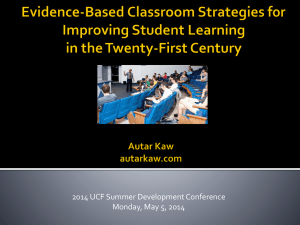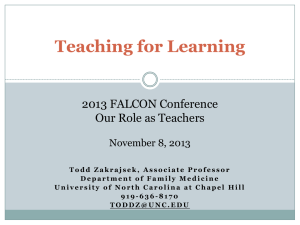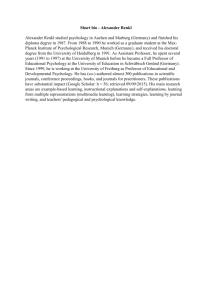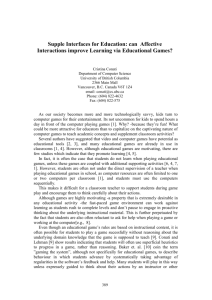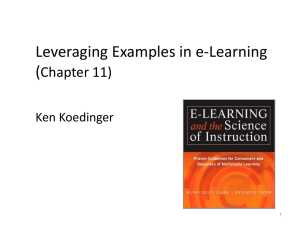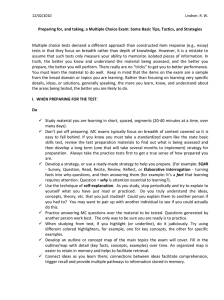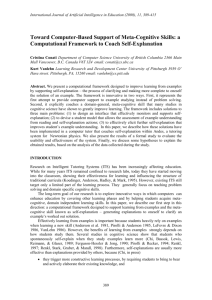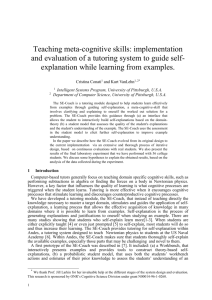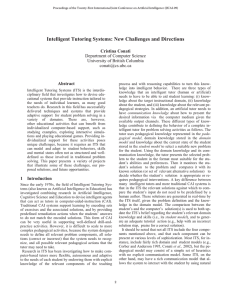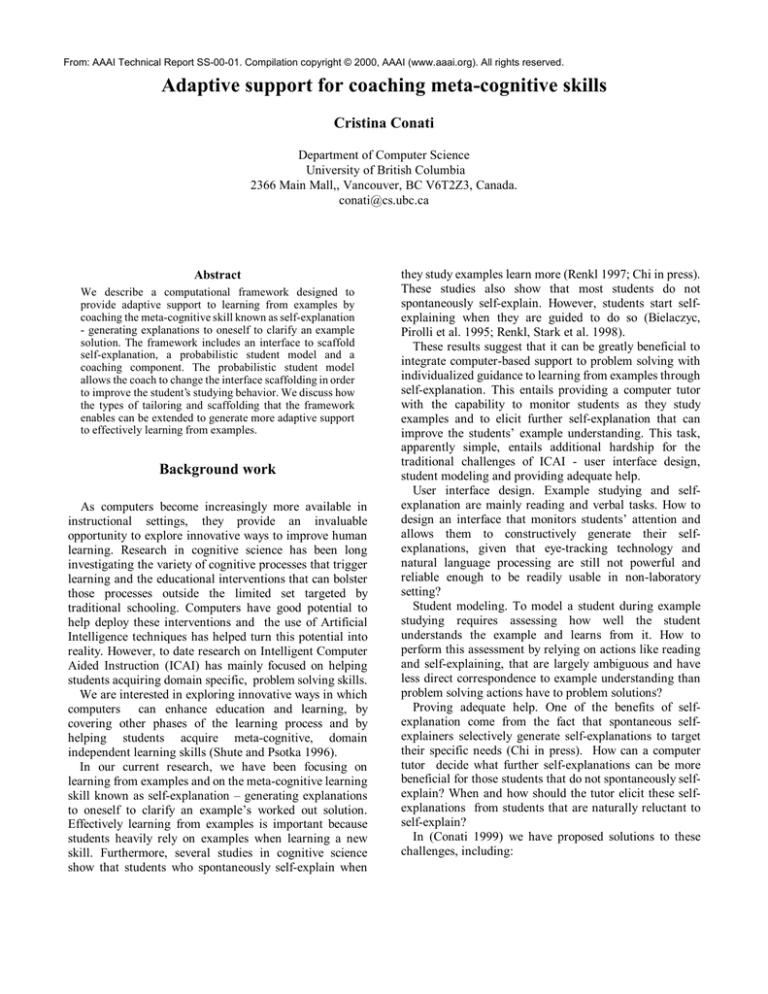
From: AAAI Technical Report SS-00-01. Compilation copyright © 2000, AAAI (www.aaai.org). All rights reserved.
Adaptive support for coaching meta-cognitive skills
Cristina Conati
Department of Computer Science
University of British Columbia
2366 Main Mall,, Vancouver, BC V6T2Z3, Canada.
conati@cs.ubc.ca
Abstract
We describe a computational framework designed to
provide adaptive support to learning from examples by
coaching the meta-cognitive skill known as self-explanation
- generating explanations to oneself to clarify an example
solution. The framework includes an interface to scaffold
self-explanation, a probabilistic student model and a
coaching component. The probabilistic student model
allows the coach to change the interface scaffolding in order
to improve the student’s studying behavior. We discuss how
the types of tailoring and scaffolding that the framework
enables can be extended to generate more adaptive support
to effectively learning from examples.
Background work
As computers become increasingly more available in
instructional settings, they provide an invaluable
opportunity to explore innovative ways to improve human
learning. Research in cognitive science has been long
investigating the variety of cognitive processes that trigger
learning and the educational interventions that can bolster
those processes outside the limited set targeted by
traditional schooling. Computers have good potential to
help deploy these interventions and the use of Artificial
Intelligence techniques has helped turn this potential into
reality. However, to date research on Intelligent Computer
Aided Instruction (ICAI) has mainly focused on helping
students acquiring domain specific, problem solving skills.
We are interested in exploring innovative ways in which
computers can enhance education and learning, by
covering other phases of the learning process and by
helping students acquire meta-cognitive, domain
independent learning skills (Shute and Psotka 1996).
In our current research, we have been focusing on
learning from examples and on the meta-cognitive learning
skill known as self-explanation – generating explanations
to oneself to clarify an example’s worked out solution.
Effectively learning from examples is important because
students heavily rely on examples when learning a new
skill. Furthermore, several studies in cognitive science
show that students who spontaneously self-explain when
they study examples learn more (Renkl 1997; Chi in press).
These studies also show that most students do not
spontaneously self-explain. However, students start selfexplaining when they are guided to do so (Bielaczyc,
Pirolli et al. 1995; Renkl, Stark et al. 1998).
These results suggest that it can be greatly beneficial to
integrate computer-based support to problem solving with
individualized guidance to learning from examples through
self-explanation. This entails providing a computer tutor
with the capability to monitor students as they study
examples and to elicit further self-explanation that can
improve the students’ example understanding. This task,
apparently simple, entails additional hardship for the
traditional challenges of ICAI - user interface design,
student modeling and providing adequate help.
User interface design. Example studying and selfexplanation are mainly reading and verbal tasks. How to
design an interface that monitors students’ attention and
allows them to constructively generate their selfexplanations, given that eye-tracking technology and
natural language processing are still not powerful and
reliable enough to be readily usable in non-laboratory
setting?
Student modeling. To model a student during example
studying requires assessing how well the student
understands the example and learns from it. How to
perform this assessment by relying on actions like reading
and self-explaining, that are largely ambiguous and have
less direct correspondence to example understanding than
problem solving actions have to problem solutions?
Proving adequate help. One of the benefits of selfexplanation come from the fact that spontaneous selfexplainers selectively generate self-explanations to target
their specific needs (Chi in press). How can a computer
tutor decide what further self-explanations can be more
beneficial for those students that do not spontaneously selfexplain? When and how should the tutor elicit these selfexplanations from students that are naturally reluctant to
self-explain?
In (Conati 1999) we have proposed solutions to these
challenges, including:
1.
An interface that monitors student’s attention through
a masking mechanism that requires the student to
explicitly move the mouse over an example part in
order to uncover and view it. Pilot studies have
revealed that the masking mechanism provides a first
level of scaffolding for self-explanation, by helping
students focus their attention. The interface also
provides menu-based tools to constructively generate
explanations without using natural language. The tools
reflect the content of a rule-based representation of the
instructional domain and provide structured accessed
to it.
2.
A student model based on a Bayesian network (Pearl
1988), to handle in a principled way the high level of
uncertainly involved in modeling learning from
reading and self-explanation actions. The student
model Bayesian network is created automatically, for
each example and for each interaction, from the rulebased domain representation and from the student’s
interface actions. The model uses latency data on
student’s attention and current estimates of the
student’s domain knowledge to evaluate the
probability that the student is spontaneously selfexplaining. The model also records the student’s selfexplanations explicitly built through the interface and
uses them to estimate the changes in the student’s
knowledge due to the interaction with the system.
3.
An algorithm to decide, given the probabilities in the
student model, which parts of the example the student
should further self-explain and how. Through
successive pilot evaluations, we have devised a
modality of intervention that coveys this information
to the students through dynamic changes in the
example presentation (e.g. highlighting of example
parts that require further self-explanations and
generation of prompts that suggest how to generate
them).
The proposed solutions have been tested in the context of
a computer tutor, the SE (self-explanation)-Coach that
provides tutoring for self-explanation within Andes, a
tutoring system for Newtonian physics that supports
students during both example studying and problem
solving. An empirical evaluation of the SE-Coach has
confirmed the usability and effectiveness of the SE-Coach
interface (Conati and VanLehn 1999) and has provided
statistical evidence that the tutorial interventions suggested
by the probabilistic student model increase students’
learning (Conati 1999).
Toward more adaptive support to effectively
learn from examples.
Although our previous work formalizes some of the crucial
processes involved in helping students learn through selfexplanation, it does not cover all of them. One of our
research goals is to extend the work to make it a more
complete computational framework to support learning
through self-explanation, in terms of the types of selfexplanations that it handles and of the tailored guidance
that it provides to generate them.
Currently, the framework explicitly guides only selfexplanations local to a certain solution step (justify the step
in terms of the domain theory; map the step onto the
underlying solution plan). However, often the examples
found in instructional material have gaps, that is they omit
some of the solution steps. This is because as students
become more familiar with a new topic, they should be
able to generate self-explanations to fill the missing steps,
thus becoming gradually accustomed to generate a problem
solution. We want to add to the existing framework the
capability to (a) guide self-explanations that fill example
solution gaps; (b) dynamically tailor the amount and kind
of the omitted steps to scaffold students in the transition
from example studying to problem solving.
The probabilistic student model is already set up to
monitor gap-filling self-explanations (Conati 1999), but the
existing self-explanation interface cannot explicitly support
them. Thus, adding to the framework the capability to
scaffold gap-filling self-explanations entails the following
objectives:
• Devise an interface that can guide the generation
of the missing parts of the example solution.
• Formalize criteria to tailor the level of detail of an
example solution to the student’s knowledge state.
This second objective includes exploring how to make
the generation of a new example completely automatic.
Currently, a problem solver automatically builds the
internal representations of an example complete solution
and the related student model Bayesian network, from the
example initial data and from the domain rule-based
representation. However, the interface presentation of the
example and the mapping that links what the student does
on this presentation to its internal formalization is coded by
hand. We will explore how to automatically generate the
example presentation from the example internal
representation. This will not only allow the system to adapt
the level of detail of an example solution to the student’s
needs. It will also facilitate adding new examples for
students to study.
We also plan to start experimenting with available eyetracking and natural language technology to verify if and
how they can improve the coaching of self-explanation.
Natural language and eye-tracking could make the
interaction with the system less constrained, by allowing
students to generate their explanations in free text and by
removing the need for the masking mechanism to track
attention. However, less constrained interaction does not
necessarily imply better learning. In particular, we
conjecture that students that do not spontaneously selfexplain or that have lower verbal skills will benefit more
from the stronger guidance provided by the current, menu
based interface with masking mechanism. As students’
knowledge and learning skills improve through the
interaction with the system, they may benefit more from
the less constrained interaction supported by eye-tracking
and natural language. We plan to test our hypothesis by
augmenting the probabilistic student model to support the
dynamic adaptation of input modalities to the student’s
level of expertise and by empirically testing how this
affects students’ learning.
References
Bielaczyc, K., P. Pirolli, et al. (1995). “Training in selfexplanation and self-regulation strategies: Investigating the
effects of knowledge acquisition activities on problemsolving.” Cognition and Instruction 13(2): 221-252.
Chi, M. T. H. (in press). “Self-Explaining: The dual
process of generating inferences and repairing mental
models.” Advances in Instructional Psychology.
Conati, C. (1999). An intelligent computer tutor to guide
self-explanation while learning frome examples. Intelligent
Systems Program. Pittsburgh, University of Pittsburgh.
Conati, C. and K. VanLehn (1999). Teaching metacognitive skills: implementation and evaluation of an
tutoring system to guide self-explanation while learning
from examples. AIED'99, 9th World Conference of
Artificial Intelligence and Education, Le Mans, France.
Pearl, J. (1988). Probabilistic Reasoning in Intelligent
Systems: Networks of Plausible Inference. San Mateo, CA,
Morgan-Kaufmann.
Renkl, A. (1997). “Learning from worked-examples: A
study on individual differences.” Cognitive Science 21(1):
1-30.
Renkl, A., R. Stark, et al. (1998). “Learning from workedout examples: the effects of example variability and
elicited self-explanation.” Contemporary educational
psychology 23: 90-108.
Shute, V. and J. Psotka (1996). Intelligent tutoring
systems: Past, Present and Future. Handbook of Research
on Educational Communications and Technology. D.
Jonassen, Scholastic Publications.

